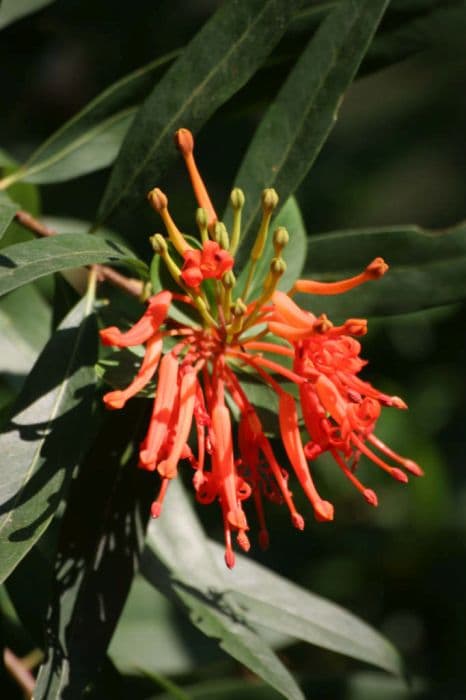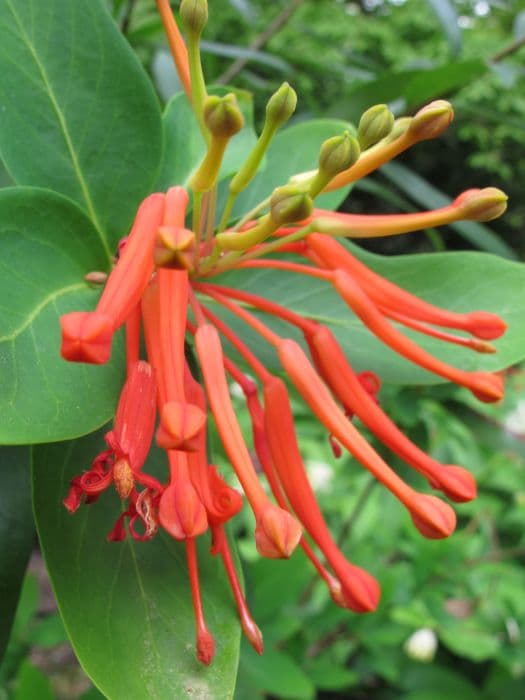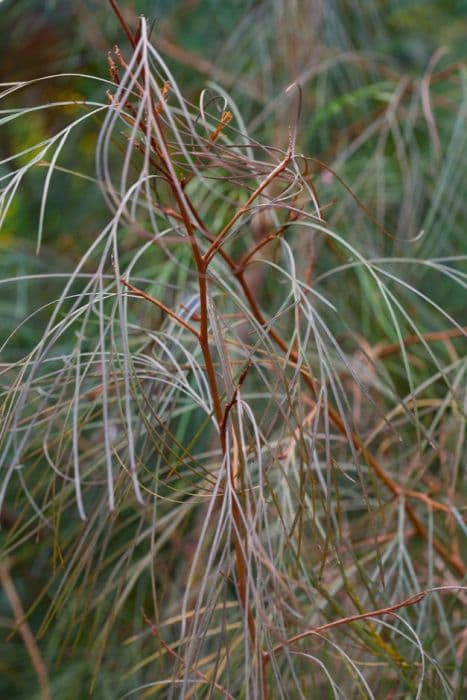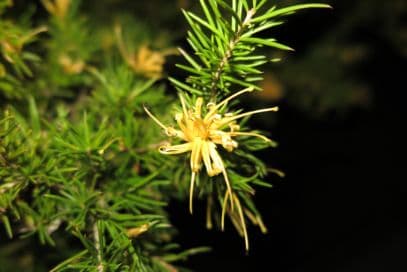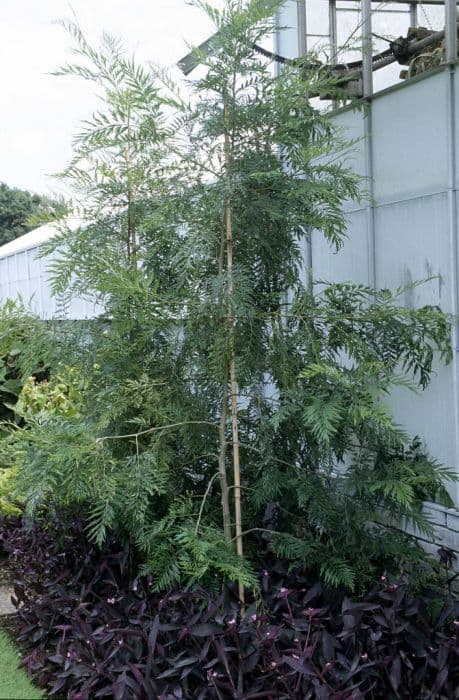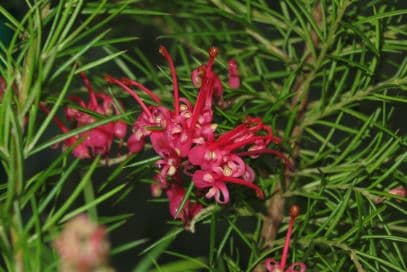Narrow-leaf Drumsticks Isopogon anethifolius

ABOUT
Isopogon anethifolius, commonly known as narrow-leafed drumsticks, is a distinctive Australian native plant with several features that make it recognizable. The leaves of this shrub are narrow and divided, resembling the leaves of dill or fennel, which gives it the part of its common name 'anethifolius', hinting at a resemblance to aniseed. These leaves are typically a deep green color, giving the plant a fine textured and bushy appearance. The narrow-leafed drumsticks produce flowers that are spherical in shape, hence the name 'drumsticks'. These inflorescences cluster together small individual flowers, which are typically a vibrant yellow color. They tend to form at the ends of the branches, prominently displayed. Over time, the flowers develop into fruits which are hard, dry, and spherical to ovoid in shape. The fruits house several seeds and can remain on the plant for an extended period before releasing their seeds. The overall look of the plant is bushy and rounded, with the attractive foliage and eye-catching flower heads making it a popular choice for ornamental gardens in suitable climates. Furthermore, the plant's resilience and ability to tolerate a range of conditions contribute to its allure as a landscaping plant.
About this plant
 Names
NamesFamily
Proteaceae
Synonyms
Narrow-leaf Drumsticks, Southern Isopogon
Common names
Isopogon anemonifolius, Isopogon anethifolius var. anemonifolius, Isopogon anethifolius var. linearis, Protea anethifolia.
 Toxicity
ToxicityTo humans
Narrow-leaf Drumsticks is not widely known for its toxicity to humans. There is limited information available regarding its potential poisonous effects if ingested, and it does not typically appear on lists of toxic plants. Therefore, it is likely that Narrow-leaf Drumsticks poses minimal risk of toxicity to humans if touched or accidentally ingested in small quantities. However, as with many plants, it is advisable to exercise caution and avoid ingesting parts of plants not known to be edible, as they may cause gastrointestinal discomfort or allergic reactions in sensitive individuals.
To pets
Narrow-leaf Drumsticks is not widely known for its toxicity to pets such as dogs and cats. There is no specific information suggesting that this plant is poisonous to pets. However, the lack of documented toxicity does not guarantee that a plant is entirely safe. As with any non-food plant, ingestion of large quantities could potentially cause mild gastrointestinal upset in pets. It is always best to prevent pets from ingesting plants not intended for consumption and to consult with a veterinarian if any signs of illness are observed after ingestion.
 Characteristics
CharacteristicsLife cycle
Perennials
Foliage type
Evergreen
Color of leaves
Green
Flower color
Yellow
Height
5 feet (1.5 meters)
Spread
5 feet (1.5 meters)
Plant type
Shrub
Hardiness zones
9
Native area
Australia
Benefits
 General Benefits
General Benefits- Landscape Aesthetics: Isopogon anethifolius, commonly known as narrow-leaf coneflower, adds architectural interest to gardens with its unique cone-shaped flower heads and fine, needle-like foliage.
- Habitat Support: It provides food and habitat for native fauna, including birds and insects, which are attracted to its flowers.
- Drought Tolerance: Once established, narrow-leaf coneflower is drought-resistant, making it a beneficial choice for low-water gardens.
- Coastal Conditions Resistance: The plant is well-suited to coastal gardens as it can withstand sea spray and sandy soils.
- Erosion Control: Its root system helps to stabilize the soil, thus it can be used to prevent erosion on slopes or banks.
- Low Maintenance: Requires minimal care once established, making it an easy plant for gardeners with limited time.
- Seasonal Interest: The plant has a long flowering season from late spring to summer, adding color and vibrancy to the landscape over an extended period.
- Cultural Significance: Indigenous to Australia, it can be used in native plant gardens to celebrate and preserve the region's botanical heritage.
 Medical Properties
Medical PropertiesThis plant is not used for medical purposes.
 Air-purifying Qualities
Air-purifying QualitiesThis plant is not specifically known for air purifying qualities.
 Other Uses
Other Uses- As a soil stabilizer: Isopogon anethifolius, commonly known as Narrow-leaf Drumsticks, can help prevent soil erosion due to its deep root system.
- In the creation of bonsai: With its fine foliage and woody stems, Narrow-leaf Drumsticks is sometimes cultivated as a bonsai specimen.
- As a natural dye: Parts of the plant can be used to produce a range of dyes for coloring fabrics or other materials.
- In perfumery: The flowers or other parts of Narrow-leaf Drumsticks might be used to extract essential oils for use in making perfumes.
- In crafting and modeling: The dried flower cones can be used in craft projects or model making for their unique texture and shape.
- As garden border plants: The Narrow-leaf Drumsticks can be effectively used as border plants because of their distinct foliage and spherical flower heads.
- In floral arrangements: Fresh or dried flower heads of Isopogon anethifolius can be used in floral displays and arrangements.
- For educational purposes: It can be used to teach botany students about plant structure and growth in proteaceae family.
- As a component in potpourri: The plant’s fragrant leaves or flowers can be added to potpourri mixes.
- As a subject for photography: With its striking flowers and foliage, Narrow-leaf Drumsticks is an excellent subject for botanical photography.
Interesting Facts
 Feng Shui
Feng ShuiThe Drumsticks plant is not used in Feng Shui practice.
 Zodiac Sign Compitability
Zodiac Sign CompitabilityThe Drumsticks plant is not used in astrology practice.
 Plant Symbolism
Plant Symbolism- Endurance: Isopogon anethifolius, commonly known as narrow-leafed drumsticks, often grows in tough, challenging environments, symbolizing the ability to withstand difficult conditions and persist through adversity.
- Resilience: With its ability to regenerate after fires, narrow-leafed drumsticks represent recovery and the power to bounce back from setbacks or disasters.
- Protection: The dense and spiky foliage of the narrow-leafed drumsticks can symbolize a protective barrier, suggesting safety and guardianship.
- Uniqueness: As a plant with distinctive spherical flower heads, narrow-leafed drumsticks signify the value of standing out from the crowd and embracing one's individuality.
 Water
WaterThe Drumsticks should be watered moderately, with deep watering being preferred to encourage root growth. It's important to allow the soil to dry out slightly between waterings, typically watering once a week depending on the climate and soil conditions. During the growing season in spring and summer, you might need to water the Drumsticks more frequently, especially if you are in a hotter climate. An approximate amount would be about one to two gallons per week for an established plant, adjusted according to the weather and soil moisture levels.
 Light
LightDrumsticks thrive best in full sunlight to partial shade. The ideal location for a Drumsticks plant is a spot where it can receive at least six hours of direct sunlight a day. However, in very hot climates, some afternoon shade can be beneficial to prevent scorching. Avoid deep shade, as it can lead to poor growth and fewer flowers.
 Temperature
TemperatureFor Drumsticks, the ideal temperature range is between 50°F and 75°F. They can tolerate temperatures down to about 20°F but should be protected from frost. Drumsticks may struggle in temperatures exceeding 90°F, so in hotter climates, providing some afternoon shade can help manage heat stress.
 Pruning
PruningDrumsticks can be pruned to maintain shape and encourage bushier growth. Pruning should be done in late winter or early spring before new growth begins. Remove any dead or damaged branches and cut back up to one-third of the plant to promote new growth. Pruning is done annually to keep the plant vibrant and well-shaped.
 Cleaning
CleaningAs needed
 Soil
SoilDrumsticks (common name for Isopogon anethifolius) thrive in well-draining, sandy soil with added organic matter. It prefers slightly acidic to neutral pH levels, around 5.5 to 7.0. A mix of sand, peat moss, and loam with added compost is ideal for promoting healthy growth and drainage.
 Repotting
RepottingDrumsticks should be repotted every two to three years to ensure they have enough space to grow. Before the onset of the growing season is the best time for repotting to minimize stress on the plant.
 Humidity & Misting
Humidity & MistingDrumsticks prefer moderate humidity levels, typical of their native Australian habitat. While they can tolerate dry conditions, a humidity level of around 40-50% is optimal for this plant's health.
 Suitable locations
Suitable locationsIndoor
Ensure bright, indirect sunlight and well-draining soil for drumsticks indoors.
Outdoor
Plant drumsticks in well-draining soil, full sun to part shade.
Hardiness zone
9-11 USDA
 Life cycle
Life cycleIsopogon anethifolius, commonly known as Narrow-leaf Drumsticks, begins its life cycle as a seed, which germinates in favorable conditions of moisture and temperature, generally after fire exposure which triggers the release of seeds from their woody fruits. The seedling emerges, growing into a small shrub, forming a deep root system to access nutrients and water. The plant then matures into an adult shrub, characterized by its narrow, leathery leaves and spherical flower heads that bloom predominantly in spring and summer. After pollination, primarily by insects, the flowers develop into characteristic seed-cones that protect the seeds inside. Over several years, the plant reaches full maturity, with cones remaining on the shrub and gradually releasing seeds, typically following environmental triggers such as bushfires. Finally, as part of their survival strategy, plants may die after fire, with the species regenerating from the soil-stored seed bank, thus completing the life cycle.
 Propogation
PropogationPropogation time
Spring to Summer
The Narrow-leaf Drumstick, or Isopogon anethifolius, is commonly propagated through seed sowing. The best time to sow seeds is in the late winter to early spring when temperatures start to rise, enhancing germination. To propagate by seeds, first, collect mature pods from the plant, which will normally split open when they're dry. Afterward, extract the seeds and sow them in a well-draining seed-raising mix. It's advisable to cover the seeds lightly with soil, about twice the thickness of the seed itself, or around 1/8 inch (approximately 3 millimeters). To ensure a good rate of germination, maintain consistent moisture and position the container in a warm, protected location with indirect light. Seedlings are typically ready to be transplanted after they have developed two to three sets of true leaves.
